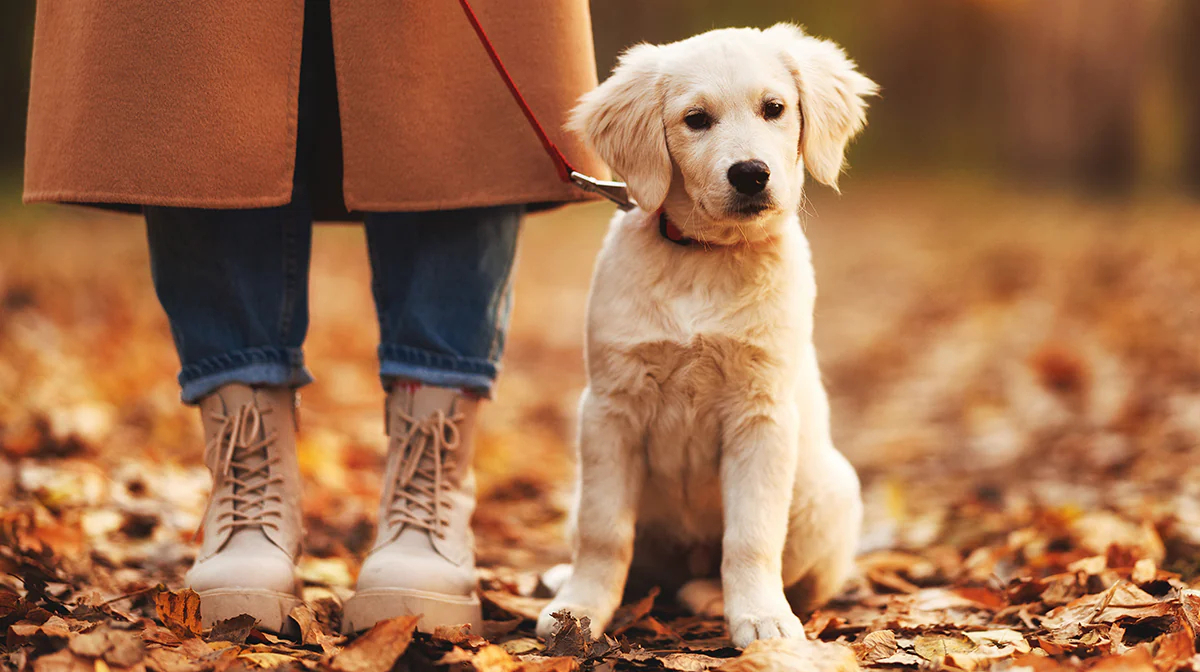
Exercise is an important part of your new puppy’s daily routine. Walking your puppy is also a great way to get your steps in together! Puppies are known for being boisterous balls of energy, and walking them (alongside plenty of playtime) helps tire them out and keep them content.
How long should you walk a puppy and how far should you walk a puppy? This handy guide will cover everything you need to know about walking your new best friend.
Puppy exercise checklist
There are a few things new owners need to know about exercising their pups. Firstly, you need to wait until your puppy is fully vaccinated before they can go for their first walk outside. Puppies can be vaccinated from 8 weeks, so assuming the first round of vaccines starts at that stage, they will be ready for their first walk at 12 weeks. Any delay with vaccines means a longer wait until their first proper walk outdoors.
During this period you can walk your pet in your enclosed garden, but they will need to be carried securely in a dog carrier or in your arms while transporting them outside your house. You must keep them away from any ground surface that may have had unvaccinated dogs on it. This is to protect them from contracting parvovirus (more commonly known as parvo) or distemper, which could both be fatal to your new puppy.
New owners should be aware of the importance of socialising new puppies even before their first big trip outside with their paws on the ground. The key socialisation stage for puppies is 3 - 12 weeks. You should socialise your new puppy around friends and family in the safety of your home during this time, using puppy treats as a reward for good behaviour. Once they are fully vaccinated and ready to go outdoors for a walk you can begin to bring them around other pets and animals, slowly but surely.
How long should I walk my puppy?
Owners often ask “How long should I walk my puppy?” There is an easy rule to help you remember how long to walk a puppy based on their age: 5 minutes of walking for every month of age, once or twice a day. For example, if your puppy is 5 months old they can enjoy a 25 minute walk once or twice a day. Once a puppy has matured they generally need 1-2 hours of walking per day, but certain breeds may need even more.
Before taking your puppy on their first outdoor walk you should also learn how to lead train your dog around your home to help avoid any extra stress on the big day.
Your main priorities when taking your puppy for their first walk are to set the pace gradually and be aware of your puppy's body language. Walking at a set pace alongside humans feels unnatural to puppies, so be sure to work up to this slowly and let your puppy take time out to investigate their surroundings.
Your puppy’s body language will give you a great insight into how your puppy feels. Be on the lookout for biting or pulling the lead, digging and overreacting to stimuli during and after the walk. These are all signs your puppy enjoyed themselves. A fixed or stiff body means they are not too happy, and a tail between their legs means they are feeling insecure around other dogs. A dog that feels threatened may also lunge or bark.
How often should I walk my puppy?
We suggest walking your puppy for 5 minutes for every month they’ve been here, once or twice a day. For example, a 3-month-old puppy can be walked 15 minutes a day, once or twice a day.
New owners should also be wary of over-exercising their puppy despite how much energy they might have, as this can lead to joint and bone problems.
How much exercise does a puppy need?
Understanding how long to walk your puppy is important but a puppy needs to enjoy a variety of different puppy exercises and games beyond walking! Puppies generally have short bursts of energy so plan your playtime in short bursts to match their energy levels.
Playtime: Your new puppy should have lots of new toys to have fun with. Plan your playtime around their favourites. Some of the best toys for puppies are engaging play toys, knotted ropes, balls to play fetch, teething chew toys and toys full of tasty treats.
Mental Stimulation: You will need to keep your new puppy mentally stimulated as well as physically. You can achieve this in many ways that are fun and engaging for both you and your puppy. Study their body language and level of interest to judge what they enjoy doing the most. We suggest things like hide and seek, training your puppy to do tricks and food-based games as puppies are generally food-motivated.
Freedom around the home: It is also important to note that you shouldn’t give your puppy too much freedom to roam your house unsupervised as they can be destructive, hurt themselves or have toilet accidents. Puppies shouldn’t be allowed to roam freely until they are around 1-2 years of age for their safety and the safety of your belongings!
Looking for more playtime inspiration? Check out these puppy exercises and games.
Can you over exercise a puppy?
Understanding how long your puppy should spend exercising based on their age is very important as it is possible to over-exercise a puppy despite their boisterous demeanour.
Over-exerting puppies can cause damage to their bones, growth plates and joints making them more likely to develop conditions such as arthritis and hip dysplasia. This is especially relevant to large or giant breeds of dogs.
Signs your puppy is exercising too much include stiffness, exhaustion, excessive panting, glazed eyes and confusion. Make sure to monitor for all of these signs and build up their fitness level slowly.
Walking your puppy - Age guide
While your puppy is below one year of age you will need to adjust the duration of their walk every month. We suggest that you add on 5 minutes of exercise every month.
1 month: 5 mins once or twice a day
2 months: 10 mins once or twice a day
3 months: 15 mins once or twice a day
4 months: 20 mins once or twice a day
5 months: 25 mins once or twice a day
6 months: 30 mins once or twice a day
7 months: 35 mins once or twice a day
8 months: 40 mins once or twice a day
9 months: 45 mins once or twice a day
10 months: 50 mins once or twice a day
11 months: 55 mins once or twice a day
12 months: 60 mins once or twice a day
Walking your puppy - Top tips
Before taking your puppy on their first outdoor walk you can also learn how to lead train them at home. This will help everything go more smoothly on the big day. We suggest you choose a harness and lead that fits your puppy well and is comfortable. Using positive reinforcement with treats is the best way to train your puppy. Start slowly and reward them when they walk well at your pace.
When you do take your puppy outside you will also need to factor in the weather conditions. Extreme weather (snow, rain, wind, heat) is a no-no, choose calm and dryer days to get your puppy used to the great outdoors.
Don’t forget the poo bags, treats for rewarding good behaviour and some water in case your puppy works up a thirst.
Walking your puppy FAQs
Check out all the most frequently asked questions about walking your puppy below.
What time of day should I walk my puppy?
Early morning and late afternoon are generally considered the best time of day to walk your puppy, however, there are no hard and fast rules. You should always try to factor in the weather and your puppy’s individual needs into your decision.
For example, in the summer it may be best to walk your puppy at night if it is very hot during the day as puppies are at a higher risk of overheating.
Is a 30 minute walk enough for a puppy?
If your puppy is 6 months old a 30-minute walk is perfect for them. Work out how long to walk your puppy by adding 5 minutes to your walk every month. For example, 3 months old = 15 minutes.
Once you have worked this out add one or two sessions of walking per day. Some breeds may need more exercise, so this is a general rule. The amount of exercise required will change again once a puppy becomes an adult.
Looking for more helpful puppy tips and advice? Join our exclusive James Wellbeloved™ Puppy Club for 50% off our Puppy Pack to help you prepare everything you need for your adorable new arrival.








